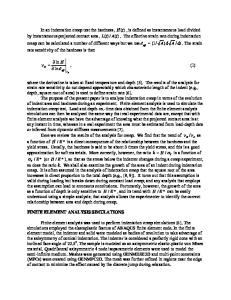The strain-rate sensitivity of the hardness in indentation creep
- PDF / 395,846 Bytes
- 11 Pages / 585 x 783 pts Page_size
- 30 Downloads / 485 Views
S. Kose Department of Civil and Environmental Engineering, University of Wisconsin—Madison, Madison, Wisconsin 53706
D.S. Stone Department of Materials Science and Engineering, University of Wisconsin—Madison, Madison, Wisconsin 53706 (Received 11 June 2006; accepted 9 October 2006)
Finite element analysis is used to simulate indentation creep experiments with a cone-shaped indenter. The purpose of the work is to help identify the relationship between the strain-rate sensitivity of the hardness, H, and that of the flow stress, in materials for which elastic deformations are significant. In general, H differs from , but the ratio H/ is found to be a unique function of H/E* where H is the hardness and E* is the modulus relevant to Hertzian contact. H/ approaches 1 for small H/E*, 0 for large H/E*, and is insensitive to work hardening. The trend in H/ as a function of H/E* can be explained based on a generalized analysis of Tabor’s relation in which hardness is proportional to the flow stress H ⳱ k × eff and in which the proportionality factor k is a function of eff/E*.
I. INTRODUCTION
Plastic deformation is a kinetic phenomenon. The underlying elementary processes are assisted by thermal fluctuations, a consequence of which is that the stress necessary to produce plastic deformation depends on how fast the material is being deformed and the temperature at which this deformation transpires. In this way the derivatives of flow stress with respect to strain rate and temperature contain information about the energy surface along the activation path.1–3 For instance, the strain-rate sensitivity of the flow stress, , is inversely proportional to the so-called “activation volume,” V*. For dislocation plasticity, V* is the product of the Burgers vector, b, and an activation area, A*, loosely interpreted as the area swept out by a segment of dislocation during thermal activation. There is not yet a universally accepted theory to account for A*, but many of the trends in this parameter may nevertheless be understood in more general terms. For instance, in the refractory body-centered cubic
a)
Address all correspondence to this author. e-mail: [email protected] DOI: 10.1557/JMR.2007.0107 926
J. Mater. Res., Vol. 22, No. 4, Apr 2007 http://journals.cambridge.org Downloaded: 28 Mar 2015
(bcc) metals, A* is independent of the level of work hardening because in these metals, the Peierls–Nabarro barrier governs the temperature-dependence of the flow stress, and the Peierls–Nabarro stress, a property of the dislocation and crystal lattice, is independent of the level of work hardening. In face-centered cubic (fcc) metals for which the Peierls–Nabarro stress is small, it is possible to detect the thermal component of the flow stress due to dislocation–dislocation interactions.4 In this case A* decreases with increasing flow stress as the spacing between pinning dislocations decreases. Most of what we know about deformation mechanisms comes from studies on bulk materials characterized under a relatively simpl
Data Loading...










